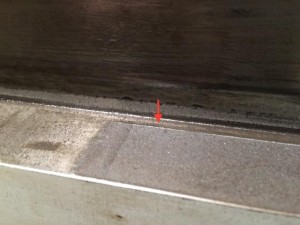I have been methodically troubleshooting the irregular impression I get on my 15-21 and have since learned about wear on the rails. I am at a point where I’m wondering if I need to do something really serious or if the amount of wear isn’t a big deal and I can somehow adjust the bearings to compensate. The upper rails that the impression bearings ride on are worn by .007 on the operator side and .002 on the opposite side at the head of the press and the wear tapers off within about 8″ down the bed of the press. I bit the bullet and embarked on adjusting the carriage bearings (did this several times thinking I was doing something wrong) and still had less impression at the head of the bed. This press has an adjustable bed so I even cleaned the wedges thinking the bed was not raising and lowering evenly. That helped a little bit.
I would rather not disassemble my press and send it out to have the rails planed because I had to knock a hole in my studio wall to get the press in and now that’s sheetrocked up. (should have put a door in!)
Someone mentioned that someone who does hand metal “scraping” might be able to even out the side with the most wear (.007) but it’s a lost art and possibly hard to find that person.
If I was able to get this one side scraped with press in place, is it a reasonable thought to adjust the bearings on that side so they ride level with the other side? I’m thinking that this metal scraping will be costly but less so than sending the press out. The opposite side impression rail being worn .002 seems not worth scraping since it would take even longer and seems negligible. I would love feedback on this. I’m particularly in need of suggestions regarding how much to adjust bearings to compensate for wear like this.
Thanks!



The wear rail folder is at hand. Vandercook applied wear rails to new presses prior to shipment, but they record only 3 Universal Is so equipped and another 11 presses including 219s, and Universal IIIs. The prints for this work allow a +/-.003″ tolerance for the finished wear strip when applied to the planed rail. The instructions say “Plane under rails as per dim’s shown” and that finished dimension with wear strip in place is .812″ +/-.003. The wear strip is 57.500″ long on the 15-21/Universal I. The bed is the same for both models, and most of the prints used to build the Universal I line are marked for the 15-21. Thus, when setting the bearings to ride on the rail, they are set to each bed rail and not equal from one side to the other. I’m not sure how you could do that. All four bearings are set at the same time and with the cylinder in the middle of the bed.
Dave Seat was intensely involved with the Hatch rebuild. That was a battered press, and the several thousand dollar rebuild was a far better investment than trying to source a replacement press.
Paul is amazingly close with his 22″ bed width estimate. It is actually 21.750″ +/-.015″.
And one of the Universal I presses equipped with wear strips was for the Wisconsin State Prison at Waupun. Maybe they were punching out license plates with the press.
Dear Seedbed Press,
Check the following scenarios:
With .007 wear at the head of one side you can do the following:
1. Adjust the bearings to the proper clearance of .003 at the .007 wear point and then when you get to the non wear portion the press will lock up due to no clearance.
2. Adjust the bearings on the non worn portion to the proper .003 and then when you get back to the head of the bed at the .007 worn portion you will have .010 clearance now and this is not conducive to quality printing.
The same goes for the other side, just not as badly.
I see three options:
1. FIX THE PRESS PROPERLY, that is if you want to do quality work with this press. It is costly but once fixed it will last many lifetimes if taken care of.
2. Do nothing and use it the way it is just knowing that you will not get fine printing at the worn portion.
3. Find someone that can use this press in it’s present condition, sell it to them and find one that you can do fine printing with. Also probably costly.
You can call me at 615-754-5500 if you want to discuss this further and I can tell you what I have run across in the past.
All our best,
Dave and Beth Seat
I’m leery of the hand scraping idea. I recommend planing both sides, then install strips to build up to the original height. This what Hatch Show Print recently had to have done for their Universal I AB. That work was coordinated by Davve Seat and with technical assistance by Fritz Klinke. It was expensive, but essentially they have a new press. The intrinsic value of flatbed cylinder proof presses is in the condition of the under rails.
Without the carriage removed the bed is only about 22 inches wide and would pass through a standard door (32″). Without the bed tapers the bed is about 6″ high and could even be turned on its side. Two large men could carry it out if necessary.